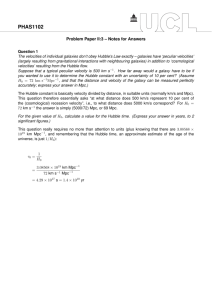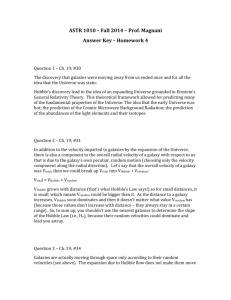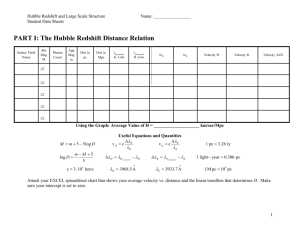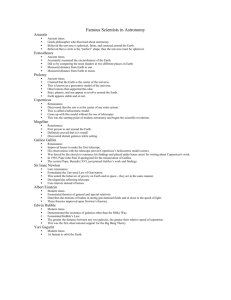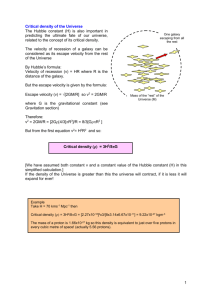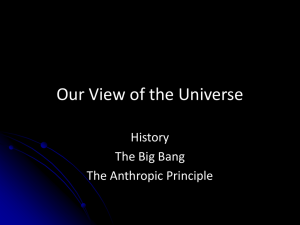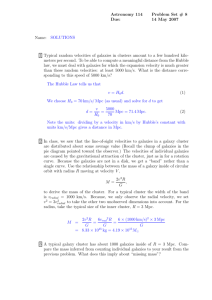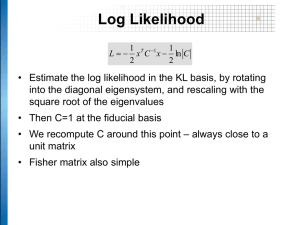Hubbleʼs Law - Answer Sheet
advertisement
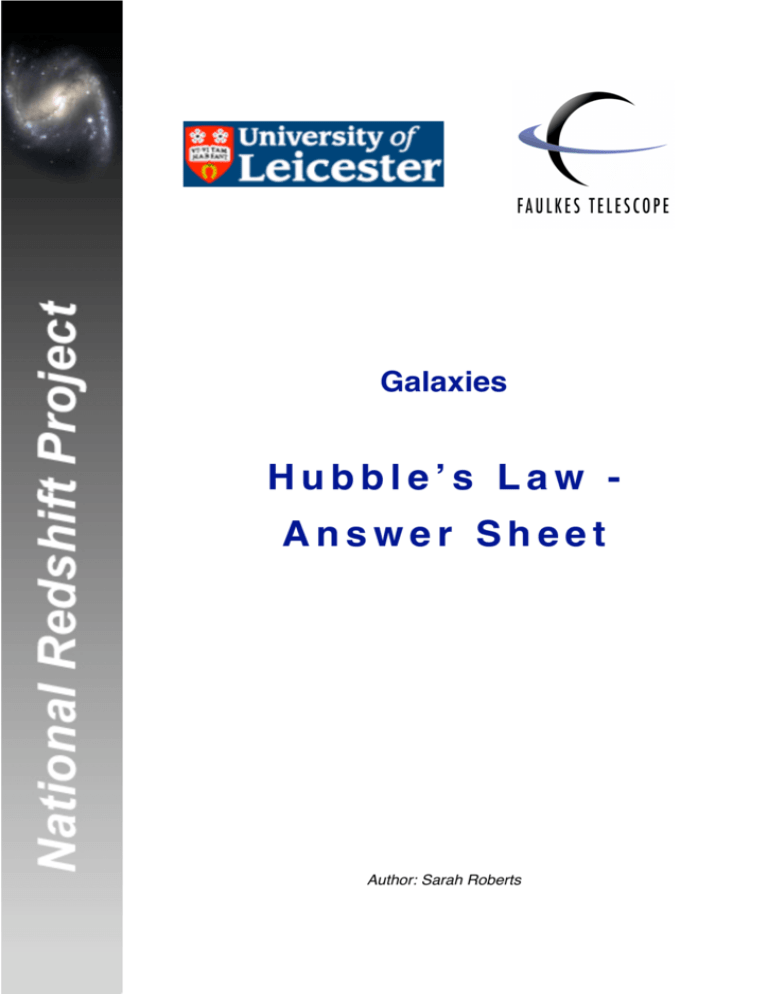
Galaxies Hubbleʼs Law Answer Sheet Author: Sarah Roberts Galaxies - Hubbleʼs Law Hubbleʼs Law National Redshift Project Figure 1. Hubbleʼs original plot of the recessional velocity of galaxies vs. their distance from us. (106 parsecs = 1Megaparsec or 1Mpc = 3.08x1019km) 1. a). When Hubble plotted his original graph, as shown in Figure 1 above, he made a mistake in the axes. Can you see what his mistake was? The units for the y axis are incorrect - the axis shows the velocity of the galaxies but the units are kilometres. b). The equation of a straight line is given by : y=mx+c Let v be the velocities of the galaxies, and d be their distance. Write the equation for Hubbleʼs graph above. Let y = v, x = d, m=H0 and c = 0 (because graph passes through the origin at 0,0) Then equation for graph becomes: v=H0d c). Using the solid black line as the line of best fit for the data in Hubbleʼs graph, calculate a value for the gradient of the line (in units of km/s/Megaparsec). National Redshift Project - 2 of 6 Galaxies - Hubbleʼs Law y 2 − y1 = gradient x 2 − x1 500 − 0 1− 0 € = gradient gradient = 500km/s/Mpc € 2. The gradient of this line is known as Hubbleʼs constant, H0, and astronomers use this constant to find the age of the Universe: Hubbleʼs Law is given by: If a galaxy has travelled at a speed v for a time t since the Universe began, it will have travelled a distance d given by: Substituting (2) into (1) gives: v = H0d d=vt National Redshift Project v=H0vt and cancelling out the vʼs gives: 1 = t H0 (2) (3) (1) (4) a). Given equation 1 above what are the units for H0? € of H0 are km/s/Mpc or kms-1Mpc-1 Units b). By converting Mpc to km, equation 4 can be used to calculate the age of the Universe. From the value of Hubbleʼs constant that you estimated from Hubbleʼs original data (as found in Question 1 (c) ), calculate the age of the Universe in seconds and years (Hint: 1 year = 31,556,926 seconds; 1Mpc = 3.08 x 1019km). From Question 1 (c), H0=500kms-1Mpc-1 Converting Mpc to km gives: National Redshift Project - 3 of 6 Galaxies - Hubbleʼs Law 500kms−1 H0 = = 1.62 ×10−17 s−1 19 3.08 ×10 km Equation 4 says 1/H0 = t = age of Universe, therefore € t= 1 = 6.16 ×1016 s −17 −1 1.62 ×10 s 1 year = 31,556,926 seconds so: € Age of Universe in years = 1.96 billion years 6.16 ×1016 t= = 1.96 ×10 9 yr 31556926 € National Redshift Project d). The age of the Sun is approximately 4.6 x 109 years old. How does this compare with the age of the Universe as calculated from Hubbleʼs original data (Question 2 (c) above)? Do these two values make sense? Explain your answer. The age of the Universe as calculated from Hubbleʼs original data was approx. 2 billion years. The Sun however is 4.6 billion years old, which makes it older than the Universe itself! This doesnʼt make sense, as the Universe must have existed before the Sun began its life. Hubbleʼs original data is inaccurate for this measurement as he was looking at different types of Cepheids, which have different period-luminosity relations, and therefore his calculated distances were incorrect. This is why his value for Hubbleʼs constant (the gradient of the graph) is so inaccurate. 3. a). The table below contains modern values for the velocity and distances of galaxies using Type Ia supernovae as standard candles. Using the appropriate ICT, or graph paper, plot the following data for the velocity (y axis) and distance (x axis) of a selection of galaxies. National Redshift Project - 4 of 6 Galaxies - Hubbleʼs Law Plot to find Hubble's constant 40000 Velocity (km/s) 35000 30000 25000 20000 15000 10000 5000 0 0 100 200 300 400 500 600 700 Distance (Mpc) Plot to find Hubble's constant 45000 40000 y = 59.184x 35000 Velocity (km/s) National Redshift Project b). Draw a line of best fit through the data points on your graph, making sure it passes through the origin (the 0,0 point) and find the gradient of this line (Hubbleʼs constant). 30000 25000 20000 15000 10000 5000 0 0 100 200 300 400 500 600 700 Distance (Mpc) National Redshift Project - 5 of 6 Galaxies - Hubbleʼs Law Gradient = 59.18km/s/Mpc c). From your value of Hubbleʼs constant, calculate the age of the Universe in years. From gradient of graph, H0=59.18 kms-1Mpc-1 Converting Mpc to km gives: 59.18kms−1 H0 = = 1.92 ×10−18 s−1 19 3.08 ×10 km Equation 4 says 1/H0 = t = age of Universe, therefore € t= 1 year = 31,556,926 seconds so: € 1 = 5.2 ×1017 s −18 −1 1.92 ×10 s 5.2 ×1017 t= = 1.6 ×1010 yr 31556926 So, age of Universe is approx. 16 billion years. National Redshift Project € d). How does this value of Hubbleʼs constant compare to Hubbleʼs original value from 1929? The newer value of Hubbleʼs constant (59.18km/s/Mpc), was 8 times smaller than the value calculated originally by Hubble. This is due to more accurate values being obtained for distances to galaxies nowadays, compared to the 1920ʼs when Hubble drew his original plot with his original data. National Redshift Project - 6 of 6
